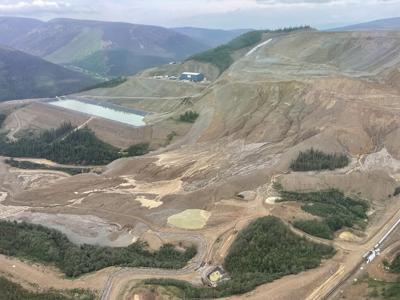WHITEHORSE - A judge has granted an order appointing a receiver to take control of assets at a gold mine closed after a massive slide of cyanide-contaminated ore in June, Yukon's justice minister said.
Tracy-Anne McPhee said in a statement Wednesday that the government had petitioned the Ontario Superior Court of Justice for the receiver after it lost confidence that Victoria Gold would take seriously the health, safety and environmental consequences of the failure at the Eagle Gold mine.
McPhee said PricewaterhouseCoopers Inc. would administer the assets and liabilities formerly under the control of Victoria Gold at the direction of the territorial government and under the supervision of the court.
"Immediate action is required to respond to the heap leach failure and its consequences for the land, water, people and wildlife in the Traditional Territory of the First Nation of Na-Cho Nyak Dun," McPhee said.
"The Government of Yukon is concerned that Victoria Gold Corp. does not possess the capacity itself and has failed to carry out the work that is required."
The minister said Victoria Gold "has failed to comply with several formal directions" issued by the government, which "require specific measures to be undertaken to address human health and safety and environmental risks and impacts."
On June 24 the heap-leach facility at Eagle Gold mine failed, causing a slide of cyanide-contaminated ore and releasing millions of litres of cyanide solution used in the gold extraction process.
Yukon officials have said some water samples taken downstream have shown cyanide levels that "significantly exceed" guidelines for aquatic life.
Brendan Mulligan, a senior Yukon government scientist, told a briefing last week that "clear evidence" of groundwater contamination had also been found, though samples with the highest concentrations of cyanide were being "contained on site."
Health officials have said that contamination does not impact drinking water.
Both the territorial government and the First Nation of Na-Cho Nyak Dun filed applications in separate courts this week asking for a receiver to be appointed, something the company said in a statement it was opposing.
Chief Dawna Hope told a news conference earlier Wednesday that the court action was the only way the First Nation could ensure that steps necessary to mitigate the disaster would be taken.
She said Victoria Gold was failing to do what was needed to protect land and water from the cyanide.
"This is unacceptable. Immediate steps are needed to address the millions of litres of toxic cyanide and other contaminants spreading from the mine site," she said.
"Every mitigation measure must be implemented to protect the lands, waters, fish, wildlife and the people impacted by this disaster. We have no confidence that Vic Gold is in a financially stable enough position to repair the environmental damages its failures have caused."
McPhee said the territorial government has entered into an agreement with the receiver to advance the money required to undertake mitigation work, which will be treated as debt to be prioritized over others owed by Victoria Gold.
At the First Nation's news conference, consultant Cord Hamilton estimated the cost of cleaning up the spill would be "something in the magnitude of order of $100 million" on top of the cost of closing and remediating the mine.
The Yukon government has previously said it has $104 million in bonds to cover remediation costs if the mine were to cease operations.
Victoria Gold CEO John McConnell did not respond to a request for comment.
The mine is located about 400 kilometres north of Whitehorse, on the traditional territory of the Na-Cho Nyak Dun, which has called multiple times for Victoria Gold to be removed from managing the cleanup.
Bill Slater, an environmental consultant working with the First Nation, told the news conference that there is not enough storage at the mine to contain the contamination and that water treatment has been ineffective.
Earlier this month the Yukon government said 68 dead fish were found following a discharge of treated water from the site.
"The lack of effective water treatment also means that existing storage on site is almost full. That includes the dynamic storage that they created by starting to pump solution back onto the heap again on July the 14th," he said.
"If not addressed, this lack of storage could lead to discharge of contaminated solution directly."
The nation has previously called for a public inquiry to look into "failures that caused this catastrophe and ensure it never happens again."
Slater said the government has ordered the company to build more groundwater collection wells, but that has not happened.
The receiver is not Victoria Gold's only legal challenge.
A Vancouver-based law firm has also filed a proposed securities class-action lawsuit against Victoria Gold, alleging the company made misleading statements regarding the safety and environmental practices at the mine, particularly concerning its heap leach facility.
The territorial government's petition for a receiver was filed in Toronto, where Victoria Gold's corporate office is located, while the First Nation filed its application in Yukon Supreme Court.
The First Nation's petition says the disaster is still unfolding and is impacting "the inherent, constitutional and treaty rights" of the First Nation.
It says the company's attempts to contain the cyanide have been inadequate and it has refused to comply with government orders.
It says the company owes the First Nation more than $750,000 in royalty payments under the agreement that permits the mine to operate.
Those allegations had not been heard in court before the decision on the territorial government's application was made.
ã By Ashley Joannou in Vancouver
This report by üСÜꪤüýò¿Øéóæòêü was first published Aug. 14, 2024.








































